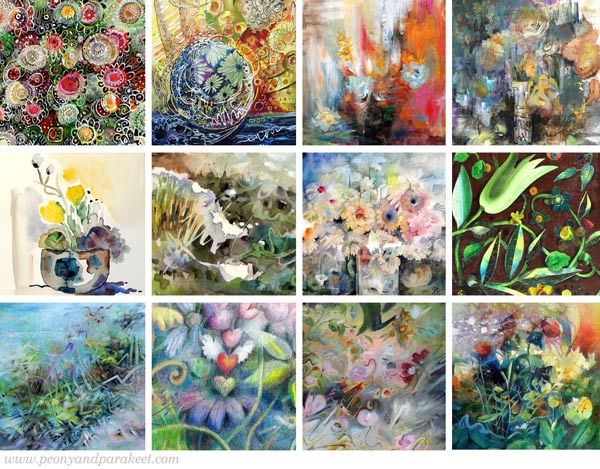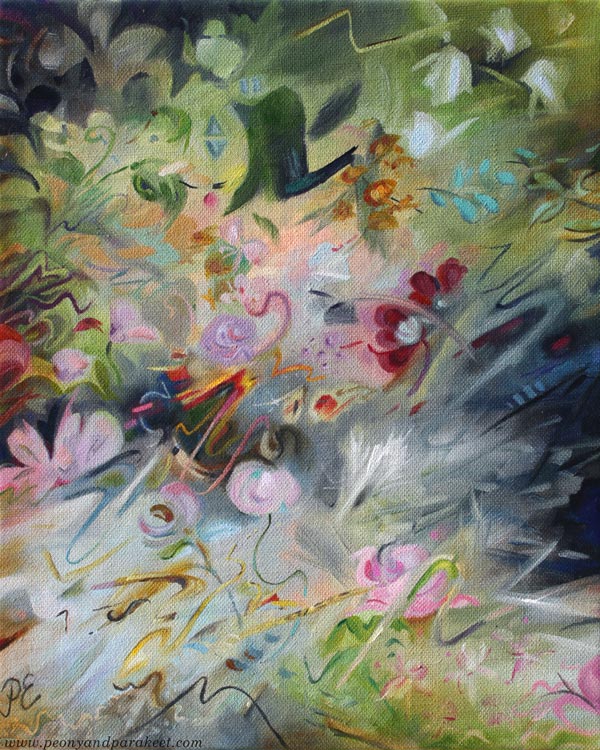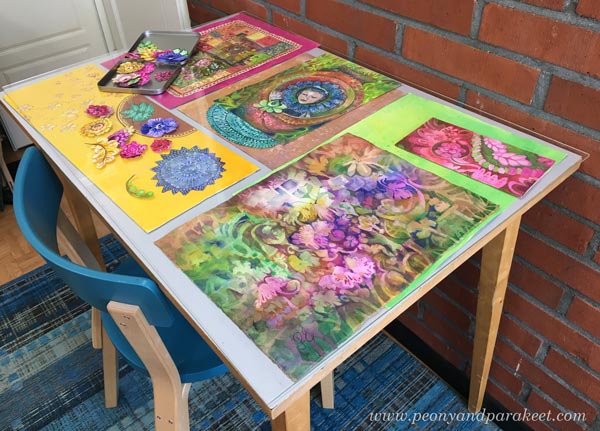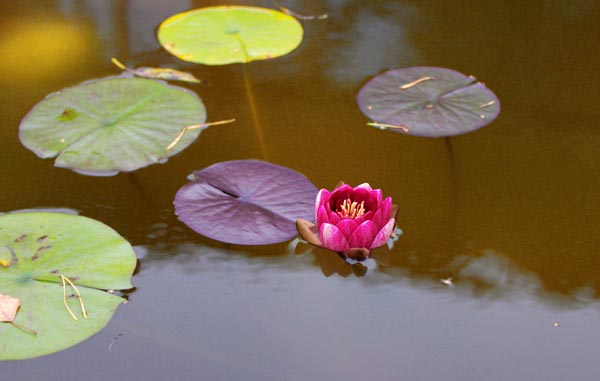Joyful Flowers with Watercolor Pencils – Watch the Video!
This week, I have a free video where I create these joyful flowers with watercolor pencils. These are inspired by fabric prints and are more motif-like than many of my colored pencil pieces. I love this kind of playing with style.

This is a small piece, just 8 x 8 inches. It’s colored freely with watercolor pencils on thick drawing paper.
Joyful Flowers – Watch the Video!
In the video, I talk about finding inspiration for art-making and tell stories about things that have affected my style. I just read abstract painter Darby Bannard‘s quote:
“Inspiration doesn’t follow style, it creates it.”
It made me want to share my thoughts about inspiration and style. I also wanted to create something colorful and cheerful that is not realistic, but more design-oriented. These joyful flowers were fun to make. After drawing the joyful flowers, I made something small to add to my boxes of joy. You can see that little flowery thing in the video too. Watch the video!
This video is a little longer than I usually post, but I personally like to watch long videos, and maybe you do too?
Joyful Coloring
My newest course Joyful Coloring teaches a color-oriented approach to watercolor pencils.

Start with blank paper and create freely with joy and sunshine! >> Buy here!
12 Spring Art Ideas from Over the Years
This week, I share spring-themed art from the past 10 years and give ideas for creating spring art.

There’s a variety of ideas and I hope everyone can find some that inspire to get creating!
#1 – For Beginners and Dull Moments
Doodle spring flowers with the mindset “more is more”!

See the blog post: Subconscious Art
Course recommendation: Collageland
#2 – For Self-Explorers
Express your spring energy by following this step-by-step exercise: Bursting Circle

See the blog post: Bursting Circle
Course recommendation: Inspirational Drawing
#3 – For Free Spirits
Splash color and let everything grow from there!

See the blog post: Art is Freedom
#4 – For Those Who Want to be Freer
When you want to be freer, the art of seeing is as important as the art of creating.
See the video of making “March Still Life”: Painting in Liberated Style

See the blog post: Painting in Liberated Style
Course recommendations: Liberated Artist Revisited and Freely Grown
#5 – For Minimalists
Pick a small piece of watercolor paper, moisten your watercolor pans, and let water do the trick.

See the blog post: Easter Still Lifes in Watercolor – Video Included!
#6 – For Travelers
Paint a spring panorama. More examples: Watercolor Panoramas to Express Travel Memories

See the blog post: Watercolor panoramas to Express Travel Memories
Course recommendation: Watercolor Journey
#7 – For Beautiful Mess-Makers
Beautify the mess by adjusting the details: paint frilly edges and draw fine lines!

See the blog post: Freely Born Watercolor Florals
Course recommendations: Floral Fantasies and Freely Grown
#8 – For Journalers
Decorate a journal cover with your original art! See more instructions in this blog post: Painted Paper Collage

See the blog post: Painted Paper Collage – 6 Tips for Intricate and Fun Art
Course recommendations: Collageland and Decodashery
#9 – For Bird Watchers
Take this challenge to move from illustration to fine art:
Step out of your comfort zone and think about a bird shape as a canvas for expressing its surroundings.

See the blog post: Pros and Cons of Becoming an Artist
Course recommendation: Floral Freedom
#10 – For Art Lovers Who Procrastinate
Reduce watching those photo-realistic colored pencil videos and start coloring freely. One heart shape can lead to many and start your flight to the world of imagination!

See the blog post: 5 Reasons Why I Love Colored Pencils
Course recommendations: Intuitive Coloring and Fun Botanicum
#11 – For Wannabe Fantasy Artists
Find the story first, then its surroundings! A character is not only described by his face.

See the blog post: Wonderland Art – Inspiration from Alice in Wonderland
Course recommendations: Magical Forest and Magical Inkdom
#12 For Artists at Heart
Our creativity has winter and spring too. We need each other to keep the inspiration going – to turn the winter into spring.
A challenge for you: How can you make a new start – create a new spring for your art?

See the blog post: New Beginnings in Art-Making
Course recommendations: Liberated Artist Revisited
Bonus Idea #1: Spring Art Display
Gather your art on a side table for display! Make a collection of all kinds of pieces – even the smallest drawings and collage pieces can look fun this way.

I have a plastic plate that is the same size as my table.
It protects my art, and it also protects the tabletop when painting in watercolor.
Bonus Idea #2: Listen to This!
I also have a music recommendation: “Kevät”
Kevät is spring in Finnish and the song was presented by a Finnish girl band Tavaramarkkinat in 1985. Here’s an English translation of the lyrics. The tone of the song is melancholic. This kind of controversy between melancholy and joy is one of the most inspiring things in spring, I think!
P.S. PostScript for Spring Art Ideas
We still have a lot of snow in Finland, and I miss spring so much! In these spring art ideas, I wanted to combine my yearning for spring and the celebration of being a full-time artist for ten years. The actual anniversary is in September, but I want to celebrate this life span the whole year of 2024.
One part of the celebration has been making the course Liberated Artist Revisited where I invite you to paint with me – to follow directions from Paivi many years ago, and then create more with the current Paivi. At the same time, you can ponder, how your art-making has changed and will change.

Because of the 10-year celebration and the nature of personal stories, Liberated Artist Revisited is a limited edition – only available for purchase until the end of March 2024! >> Buy Now!
Writing About Art
This week is dedicated to writing about art. I tell how I write these blog posts, and why it’s beneficial to write about art.

See more pics of this piece in the Taiko online art store!
How I Write a Blog Post
I have been writing these blog posts for years directly in English, so, in a language foreign to me. I wanted to develop my language skills and it seemed like the best method, even if the expression was sometimes limited. This year, I started to write these stories in Finnish first. Once the Finnish text is done, I translate it into English. I edit the translation 2-4 times before the story is finished.

You might imagine that this is a slow road, but I have developed as a writer in such a way that it feels natural to push the story out first and then edit it. When editing, the subject becomes more clear and the images and texts work better together.
I love the interaction between two languages.
When I write in Finnish, I’m already thinking about English. In Finnish, passive constructions and long expressions are used a lot. I’ll try to be more concise right at the beginning. Words and expressions also differ. In Finnish, I can easily get a relaxed and even humorous tone, but I can’t translate it into English, and neither can machine translators. However, I don’t mourn the matter, I think that the union of two languages is like a marriage: both have to give way.

Joyce Carol Oates talks about having a journal separate from the stories and novels. The journal could be more honest and raw, and use a little different style than what ends in the publication. For me, the Finnish script is a bit like that – a stream of thoughts that gets refined with edits.
The Relationship Between Images and Text
I used to enter the images into the post first and then write the texts directly between them. But these days I work in a word processor so that I only focus on the text. I can write more freely and the texts become more authentic and have more content. I can then fit the images between the text and add captions if needed.

Although I decide the topic of a blog post when I start writing it, most of the pictures exist before the text. I strive to always have new photos and I often plan the collection of images weeks in advance. Since this blog is about art and is aimed at visual people, I need lots of pictures. I want to inspire the reader to make art, so the pictures need also express the process, and not just finished works.
Writing Moves Art Forward
Nowadays, many have left blogging and moved to posting on Facebook or Instagram or uploading videos to YouTube. I too write regularly on my Facebook page and Instagram account. Every now and then I also make a video on YouTube.
But writing is magical. When you write a longer story, you don’t just write to others but to yourself too.

And I am not the only one who thinks that way. Last spring, I participated in an artist coaching program by the Finnish Art Agency, where the coach wanted us to write regularly about our art. She emphasized that working with words is important because visual artists often need to tell about their art.
Writing About Art is Almost Similar to Talking About Art
I believe that all who create art also want to talk about it. It’s just very difficult sometimes. Pictures go to the other side of the words and the ideas get mixed up.

Talking about your art can also feel like pompous boasting, even if the recipient would be interested. Long art stories can also bore the listener if she is not as deep in creating. The same applies to writing, you can feel pretentious or be afraid to bore someone, but when you write it’s easier to notice when you’re stuck and repeating yourself.

My art has not only developed by drawing and painting diligently. It evolves every time I write about it. It has developed by blog posts, manuscripts for classes, short video posts, and even description texts, where I have to briefly tell who I am or what inspired me to create a certain piece.

Writing brings out problems. You have to focus on what you really want to say and tell who you really are. There will be a temptation to find words that sound great but not say the truth. But if you can overcome the lure of meaningless words, creativity in you wakes up.

I have noticed that when I can put my wishes and ideas into words, they begin to appear in my paintings. Our creativity strives to fulfill our wishes if it can read them. So, that’s why I am writing about art weekly. Thank you for making me do that!
Do you write – or plan to write – about your art? Tell us more!
How to Create Comforting Art
This blog post is for you who want to spread more joy through your art, and make your art more comforting and captivating.

I am listening to an interesting course on writing. It’s Neil Gaiman Teaches the Art of Storytelling. Writing and making a picture have a lot in common. When you look at your piece, can you find a story – so, a conflict and a solution?
Conflict Creates More Comfort
Neil Gaiman says that beginning writers leave conflict out of their stories. And that it’s the conflict that makes the story interesting. The same goes for the picture. Beginner artists usually want to use only happy colors and draw or paint only beautiful and joyful things.
I too want to make comforting art – something that takes me to a softer world right in the beginning and that will lift the viewer’s mind when finished. But the conflict must still be allowed because first showing it, and then finding a solution for it, creates comfort and happiness.

Purchase this painting via the Taiko art store!
For example, in this watercolor painting above, the flowers have run indoors because it has started to get windy and rain a little.
Imagine how they first evaluate the houses: “Where would we be welcomed the most?” And then they would push through the darkest window and settle on the windowsill close to each other.
Imagine stepping into that room and seeing shattered glass and feeling unpleasant coldness. But then the colorful flowers would bend towards you. What a pleasant surprise to receive in these windy times!

When I painted this, I wanted to protect myself from the winds of the world. I started with the flowers, but the painting only came true when the wind joined in.
Overcoming Difficulties Brings Comfort
For me, the most comforting art is the one where difficulties are overcome. For example, in this painting, the flowers have experienced loss, but are still ready to take risks again.

Build Different Characters
Neil Gaiman says that his stories are largely in the hands of the characters. Also in painting, you have to identify the main characters. Blots easily turn into flowers, but don’t leave it at that! Make small changes to the shapes so that the personality of each flower comes out. Often it’s a very small adjustment that a beginner easily ignores as insignificant. The skill of building an expression for a form no matter what it represents develops with making.
Strong characters and an understanding of the place where everything happens create a story in the picture. My main characters are strong-minded and independent and the conflict is often a fight against wild conditions.
For example, winter has arrived here, but the flowers stubbornly decide to turn the clock back to a warmer time. In this conflict, the flowers lose their color to stay alive.

Sometimes what feels good at first can break down in the long run. Can a flower live only in light? Don’t we get a better understanding of our outlines and boundaries in the shadows?

On the other hand, when life has been nothing but darkness and the colors have faded, the power of light enables a fast recovery.

Observe the Surroundings with Empathy and Imagination
As a director of disaster films, I am inspired by the survivors around me. This autumn, I listened to the lily of our new pond, who described how boldly she would soon bloom. Fall progressed and my suspicion grew. But just before the big storm, the bud opened for one day.

You can survive of the deep waters – even only for a moment!

The world of inanimate objects is also full of ideas when you use your imagination.
For example, wallpaper is one of the most pathetic things I know. The flowers are glued in place, but they still see and hear everything. If they were released, a lot of pent-up energy would be present. The silent and motionless wall flowers would party around the room. They had been thirsty for life for a long time.

Isn’t that what happens when a person starts creating art? The frenzy inside her finally gets out!